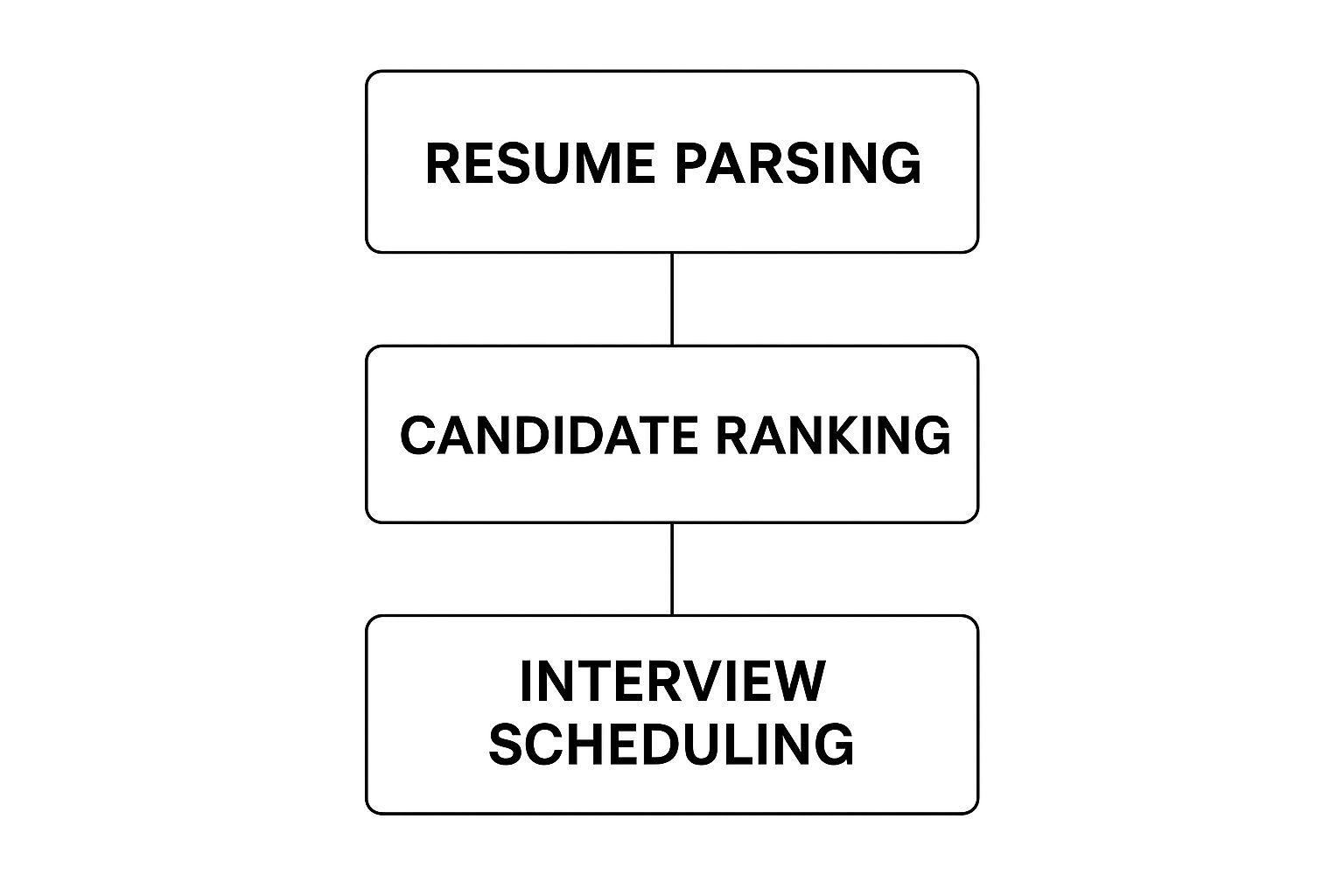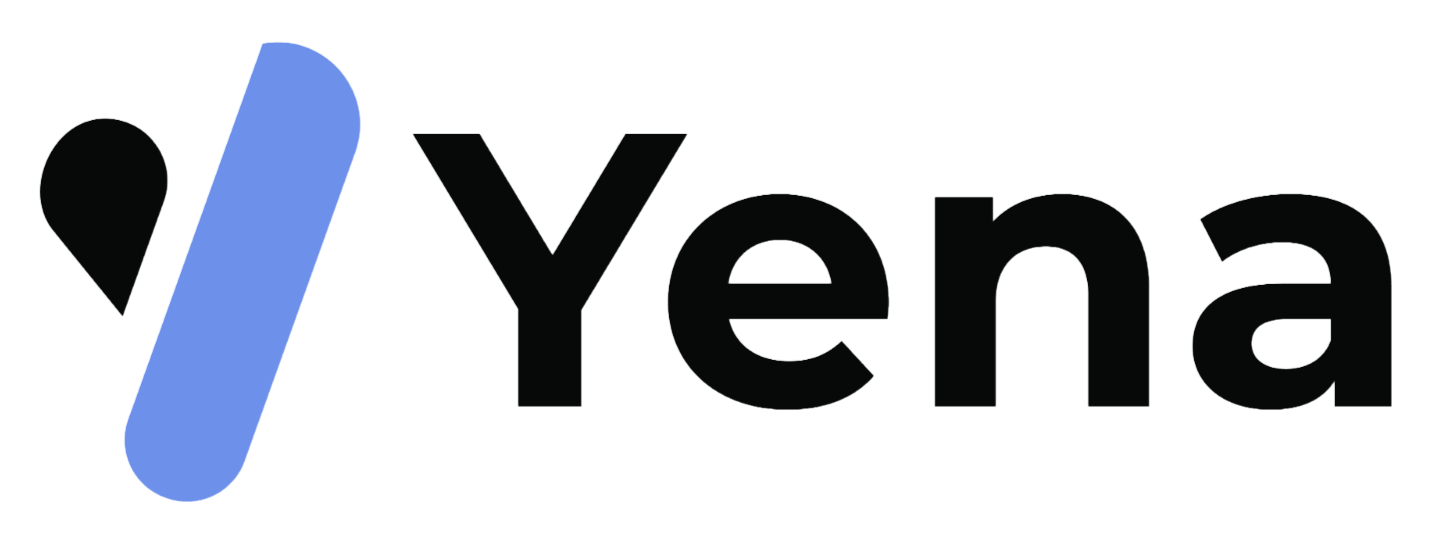Application Tracking System: Boost Your Hiring Efficiency
- Janis Kolomenskis
- Jun 19
- 13 min read
What Your Application Tracking System Actually Does for You
Forget the idea of an application tracking system (ATS) as just a digital filing cabinet. It’s better to think of it as the central nervous system for your entire hiring operation. It doesn't just sit there storing résumés; it actively coordinates every step, from the moment a candidate applies to the day a job offer is sent out. For hiring managers, this changes recruitment from a frantic search through spreadsheets and email threads into a smooth, organised, and predictable process.
The true strength of an application tracking system is its ability to centralise and automate recruitment tasks. Just picture trying to set up interviews for five candidates with three different team members—it's a logistical nightmare. An ATS takes on this headache by finding the best time slots based on everyone's calendar, sending out automated reminders, and keeping all communication neatly organised in one spot. This automation frees up a huge amount of time, letting recruiters focus on what really counts: finding and evaluating top talent. For more details, you can explore our ultimate guide to a candidate tracking system.
From Data Storage to Strategic Partner
Today’s systems do far more than just collect data. They are a strategic partner that offers crucial insights to shape your recruitment strategy. This diagram shows a basic workflow where an ATS scans résumés and helps manage candidates as they move through the hiring stages.

This workflow demonstrates how the system brings order to the hiring process, making sure no candidate slips through the cracks and every action is tracked. This level of organisation is vital, particularly when handling a large volume of applications. It helps create a positive experience for candidates and protects your reputation as an employer.
A Tool for National-Scale Efficiency
The benefits of a good application tracking system aren't limited to private companies; public sector organisations also see immense value. In Latvia, for example, the State Employment Agency (SEA) is working to modernise its services with better digital systems. With a tight budget for labour market policies—just 0.14% of GDP, significantly below the EU average—efficiency is absolutely critical.
By digitalising its application tracking, the SEA can more effectively manage the high ratio of jobseekers to counsellors. This ensures that its limited resources are put to the best possible use, connecting people with job opportunities. This real-world case shows that a well-implemented system is more than a business tool; it's an essential piece of infrastructure for economic growth and workforce development. You can learn more about these efforts to modernise Latvia's public employment service.
Essential Features That Make or Break Your Hiring Success

When you're choosing an application tracking system, it’s easy to get lost in a sea of features. The real challenge is telling the difference between a flashy extra and a genuine game-changer for your hiring process. A truly effective ATS does more than just store information; it should actively make your team's recruitment tasks simpler and more successful.
Think of it like setting up a professional kitchen. A home cook might be tempted by all sorts of single-use gadgets, but a seasoned chef knows success comes from the essentials: a sharp knife, a sturdy cutting board, and a reliable stove. In the same way, your ATS needs a core set of features that work together to create a smooth and efficient hiring machine.
Core Capabilities for Modern Recruiting
A strong application tracking system stands on a few essential pillars. These are the features that elevate a simple tool into a powerful platform, giving your team a genuine edge. In fact, the right capabilities can improve the hiring process for 94% of recruiters, showing just how much of a difference a well-chosen system can make.
Here are the features that truly count:
Automated Candidate Screening: Imagine an intelligent assistant that scans résumés for the specific skills and experience you need. This isn't about removing the human element but about building a qualified shortlist quickly. It frees your recruiters from the tedious task of manually sifting through hundreds of applications.
Collaborative Hiring Tools: Hiring is a team effort. A great ATS acts as a central hub where recruiters, hiring managers, and interviewers can all share notes, provide feedback, and track a candidate's journey. This single source of truth prevents miscommunication and keeps everyone aligned.
Customisable Workflows: No two companies hire in exactly the same way. A rigid system forces you to adapt your process to its limitations. A flexible ATS, however, lets you build custom pipelines that perfectly mirror your unique recruitment stages, from the first application to the final offer.
Analytics and Reporting: Your Strategic Compass
Beyond managing daily tasks, a top-tier ATS gives you the data needed to make smarter, more strategic decisions. A basic system might show you the number of applicants, but an advanced one offers deep insights into what’s working and what isn’t.
To help you distinguish between the must-haves and the nice-to-haves, this table compares features across different system types.
Essential ATS Features Comparison
Comparison of core ATS features across different system types and their impact on recruitment efficiency
Feature | Basic Systems | Advanced Systems | Impact on Efficiency |
|---|---|---|---|
Reporting & Analytics | Tracks basic metrics like applicant volume. | Analyses source effectiveness, time-to-hire, and identifies pipeline bottlenecks. | Moves from simple counting to strategic, data-driven planning. |
Candidate Communication | Relies on manual email templates and scheduling. | Offers automated, personalised messaging and integrated interview scheduling. | Drastically cuts down on administrative work and improves the candidate experience. |
System Integration | Offers limited or no connections to other software. | Seamlessly connects with calendars, job boards, and other essential HR tools. | Creates a unified tech stack, which stops manual data entry and reduces errors. |
This comparison makes it clear how advanced features directly contribute to a more efficient and effective hiring process.
Ultimately, the right features change an ATS from a passive digital filing cabinet into an active partner in your recruitment efforts. It automates the monotonous work, encourages better team collaboration, and provides the crucial insights you need to refine your strategy. This ensures you not only fill roles faster but also make better hires.
Why Smart Companies Can't Survive Without These Systems

Trying to recruit in today’s talent market without an application tracking system is like running a busy restaurant using only handwritten orders. It might work for a little while, but it’s slow, messy, and you’re bound to make costly mistakes. This outdated method puts you at a real disadvantage against competitors who have adopted modern tools. The main point isn't just about staying organised; it's about winning the race for top talent while others are buried under email attachments and jumbled spreadsheets.
Forward-thinking companies invest in an ATS because they’ve felt the sting of a chaotic hiring process. They’ve seen a brilliant candidate accept another job simply because their own process dragged on for too long. They've struggled to give timely updates, leaving great applicants feeling ignored and tarnishing the company’s reputation. When a standout CV vanishes into a crowded inbox, it’s more than just a clerical slip-up—it’s a lost opportunity to make the team stronger. An ATS is the safety net that prevents these valuable chances from falling through the cracks.
Transforming Chaos into a Competitive Advantage
Moving to a dedicated application tracking system does more than just solve logistical problems; it changes your entire recruitment philosophy. One of the first benefits you’ll notice is having a single source of truth for all hiring activities. This central hub ensures recruiters and hiring managers are always aligned, putting an end to the "I thought you were doing that" mix-ups that can stall progress. For more insights on refining your hiring, you can learn how to enhance your talent management system for better results.
This systematic approach gives you a powerful competitive edge. A smooth, transparent, and professional candidate experience becomes a major selling point for your company. When applicants feel respected and kept in the loop, they view your organisation in a positive light, even if they aren't hired. An application tracking system isn't just another piece of software; it's a strategic instrument. It helps you build stronger, more skilled teams faster by making sure you never lose out on top talent due to a disorganised process. This frees you up to focus on what really matters—building relationships and turning recruitment from a reactive chore into a proactive driver of business success.
Choosing the Right Application Tracking System Type
Selecting the right application tracking system isn't a one-size-fits-all task; it’s a strategic choice that needs to fit your company’s size, hiring goals, and recruitment complexity. Think of it like choosing a vehicle: a zippy sports car is perfect for a solo driver on open roads, but a family of six needs a spacious minivan for their daily routine. In the same way, a rapidly growing startup has very different needs from a global enterprise. Picking the wrong system can create unnecessary friction and slow you down.
The ATS world is generally split into two main camps: standalone, best-of-breed systems and integrated HR suites.
Standalone Systems vs. Integrated Suites
It's a classic debate: do you want a specialised tool that does one thing exceptionally well, or an all-in-one platform that handles multiple jobs?
Standalone Application Tracking System: This is a dedicated tool focused entirely on recruitment. It excels at optimising the hiring journey with powerful features like advanced candidate sourcing, in-depth analytics, and first-class candidate experience management. Startups and recruitment agencies often lean towards this model for its agility and feature depth.
Integrated HR Suites: These platforms bundle an ATS with other HR functions like payroll, onboarding, and performance management. This all-in-one approach is attractive for organisations looking to consolidate their technology, creating a single source of truth for all employee data.
The infographic below shows the core workflow that an effective application tracking system automates, guiding candidates from their initial application to the final interviews.

This process demonstrates how each stage logically builds on the last, turning a high volume of applicants into a manageable group of qualified candidates for your team to meet.
Real-World Applications and Trends
Picking the right system also means considering how the technology is used in practice. For instance, Latvia introduced a centralised graduate tracking system in 2019, applying application tracking system principles to monitor graduates' journeys into the workforce. By 2022, this data-first approach was giving universities priceless feedback on how well their courses prepared students for the job market. This forward-thinking public sector project shows just how versatile these systems can be beyond typical corporate hiring. You can discover more insights about Latvia's approach to graduate tracking.
Ultimately, your decision should come from a clear-eyed view of your current processes and future ambitions. Make sure the system you choose can grow with you.
Implementation Strategies That Actually Work in Practice
Rolling out your new application tracking system is about more than just flipping a switch on new software; it's a project in managing change. A great launch depends on bringing your team along on the journey, helping them see the system not as another chore, but as a powerful new tool in their arsenal. Too many companies get caught up in the technical details and forget the people who will use the ATS every single day.
The best first step is to approach the implementation like any other important business project. Imagine you’re building a new digital headquarters for your recruitment operations. You wouldn't start without a detailed blueprint, and the same thinking applies here. This requires a solid plan with clear phases, from the initial setup and data migration to team training and the final company-wide launch.
A Phased Rollout for Smoother Adoption
Instead of causing disruption with an all-at-once switch, a phased rollout minimises chaos and creates opportunities for crucial feedback. This approach helps your team build confidence and get comfortable with the new tool one step at a time. It also lets you spot and fix any workflow hitches before they impact your entire hiring process.
Here’s a practical, step-by-step approach to guide your deployment:
Phase 1: Configuration and Data Migration. This is the foundational stage where you set up your hiring workflows and import existing candidate information. Clean, accurate data is essential. Think of this as a chance to archive old, irrelevant records and begin with a fresh, well-organised candidate database.
Phase 2: Pilot Group Training. Choose a small, tech-friendly group of recruiters and hiring managers to act as your system champions. Give them thorough training and let them use the ATS for a real, live job opening. Their hands-on experience and feedback are incredibly valuable for fine-tuning your setup.
Phase 3: Team-Wide Training and Launch. Using the insights from your pilot group, you can now train the entire team. Your training should focus on real-world scenarios, not just a tour of features. Once everyone feels ready, you can officially launch the system for all departments to use.
Measuring Success Beyond the Launch
The job isn't done just because the system is live. To make sure you’re getting real value from your investment, you need to track your progress with clear, measurable goals. This is where you can see if your new recruitment "headquarters" is truly operating efficiently.
The following table provides a detailed breakdown of what to expect during each phase of the rollout, with key activities and metrics to gauge your success along the way.
Phase | Duration | Key Activities | Success Metrics |
|---|---|---|---|
Phase 1: Planning & Configuration | 2-4 Weeks | Define workflows, configure user roles, set up job templates, plan data migration. | All core workflows mapped; 100% of user permissions correctly assigned. |
Phase 2: Data Migration & Pilot | 1-3 Weeks | Import existing candidate data, conduct a pilot test with a select group of users. | 99% data accuracy post-migration; Positive feedback from 95% of pilot users. |
Phase 3: Training & Go-Live | 2-4 Weeks | Train all recruiters and hiring managers, launch the ATS company-wide. | 90% of all users complete training; System officially live on schedule. |
Phase 4: Post-Launch & Optimisation | Ongoing | Monitor adoption rates, gather user feedback, make workflow adjustments, measure KPIs. | 30% reduction in time-to-fill within 6 months; 90% user adoption rate. |
This detailed plan shows that a successful ATS rollout is a continuous process.
By following a structured implementation plan and consistently measuring your success, your application tracking system will become a fundamental part of how you attract and hire top talent.
Getting Maximum Value From Your Application Tracking System
Investing in an application tracking system is the first step, but the real win comes from using its data to make smarter, faster hiring decisions. Think of your ATS as a high-performance vehicle. Owning it is one thing, but knowing how to use its full potential to win the race for talent is what truly sets you apart. The best companies don't just use their system to organise résumés—they treat it as a strategic compass for their entire recruitment operation.
The key is to move beyond simple tracking and start using analytics. Your ATS is a goldmine of data that shows you exactly how healthy your hiring process is. By digging into this information, you can pinpoint the exact stage where candidates are dropping out or where bottlenecks are slowing things down. For instance, if you see many qualified applicants withdraw after the first interview, it might point to an issue with your interview process or communication, prompting a much-needed internal review.
Turning Data Into Actionable Insights
Successful organisations use ATS data to sharpen their approach in several critical areas. They analyse which job boards and sourcing channels bring in the highest quality candidates, allowing them to focus their budget and effort where it delivers the most impact. Imagine finding out that a niche industry forum brings in 50% more qualified software engineers than a major job board. That insight helps you reallocate your resources for a much better return.
Furthermore, a well-managed application tracking system is essential for building proactive talent pipelines. Instead of starting from zero with every new job opening, you can nurture a pool of pre-vetted, interested candidates. When a new role opens, you have a warm list to contact immediately, which drastically shortens your time-to-fill. Some companies have improved this metric by as much as 30% simply by strategically growing their talent community through their ATS.
Measuring Your Return on Investment (ROI)
To truly understand the value of your ATS, it's vital to measure both the tangible and intangible benefits.
Hard Metrics: These are the straightforward numbers you can count. Track reductions in cost-per-hire, shorter time-to-fill, and lower spending on external recruitment agencies. These figures provide clear proof of financial value.
Soft Benefits: Don’t ignore the less obvious victories. An efficient system boosts recruiter satisfaction because they spend less time on admin and more time engaging with people. It also greatly improves the candidate experience, which strengthens your employer brand and makes your company a more desirable place to work.
By actively using all the features of your application tracking system, you change it from a simple database into a powerful engine for business growth, making sure you consistently attract and hire the best people for your team.
Avoiding Costly Mistakes and Maximising Your Success
Even the most capable application tracking system won't deliver results if it isn't chosen and managed thoughtfully. One of the most frequent errors is picking a system based on an impressive feature list rather than your company's real, day-to-day workflow. It's easy to get excited by advanced analytics or intricate automation, but if those tools don't match how your team actually works, they become expensive distractions instead of helpful assets. A great implementation starts with an honest look at your genuine needs, not just a vendor's sales pitch.
Another major misstep is overlooking the human element of technology adoption. A new ATS changes how people do their jobs, and resistance is a completely normal reaction. Simply launching the software with a quick training session is a formula for low usage and frustration. Wildly successful implementations happen when leaders actively support the change, clearly explain the "why" behind the new system, and offer continuous support. The goal is to show your team how the tool makes their work easier, not just add another task to their to-do list. Without this buy-in, even the best system will end up collecting digital dust.
Best Practices for Long-Term Effectiveness
To make sure your application tracking system stays a strategic advantage and not just a messy database, you need to commit to its ongoing health and upkeep.
Here are some proven practices to keep your system performing at its peak:
Maintain Data Hygiene: Regularly clean your candidate database. This involves archiving old, inactive profiles and making sure all information is up-to-date and correctly tagged. Clean data results in reliable analytics and more effective talent pipelines.
Conduct Regular Audits: At least twice a year, review your workflows. Are there bottlenecks you can smooth out? Are your job posting templates still performing well? This proactive approach keeps your process sharp and in line with your company's changing needs.
Continuously Train Your Team: When you hire new managers or your system introduces new features, hold refresher training sessions. Consistent education ensures everyone is using the tool to its full potential and following best practices. For a closer look at the data you should be tracking, you might find our guide on essential recruiting metrics to improve hiring in 2025 helpful.
By sidestepping these common pitfalls and sticking to best practices, you turn your ATS from a simple organisational tool into a lasting competitive edge. It becomes the engine that drives a smarter, more efficient, and successful recruitment strategy for years to come.
Ready to implement an ATS that your team will actually love to use? Discover how Yena’s AI-powered Hiring OS combines powerful automation with an intuitive design to make hiring faster, smarter, and more human.

Comments